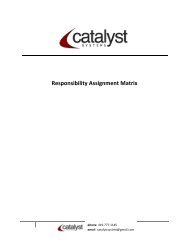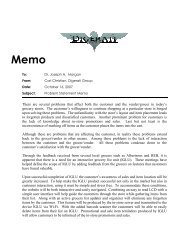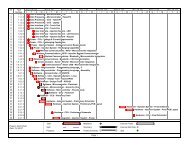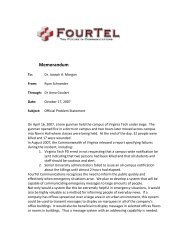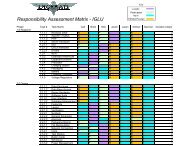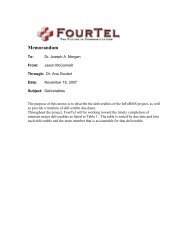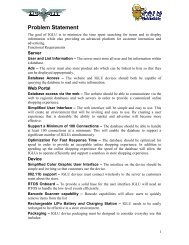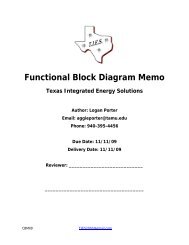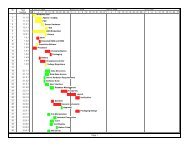White Paper - Capstone Experience - Texas A&M University
White Paper - Capstone Experience - Texas A&M University
White Paper - Capstone Experience - Texas A&M University
You also want an ePaper? Increase the reach of your titles
YUMPU automatically turns print PDFs into web optimized ePapers that Google loves.
“Merging the past with the present”<br />
SPONSORED BY:<br />
FACULTY ADVISOR: PROFESSOR GEORGE WRIGHT<br />
RHYVLE TECHNOLOGIES<br />
TAIWO ADEBIYI<br />
WILLIAM KOONCE<br />
BRADLEY SANDERS<br />
BRAD WOODARD<br />
OCTOBER 15, 2007
| 10/15/2007<br />
CLASSIC COMFORT<br />
“Merging the past with the present”<br />
INTRODUCTION<br />
Background<br />
Throughout the years, building, customizing, and maintaining classic cars has remained a<br />
popular hobby for people of all ages. Some go to great lengths and invest innumerous amounts of<br />
time and money into their automobile. Over many years, technology has obviously advanced. The<br />
wiring in cars today has greatly improved. Many of these classic car enthusiasts have always<br />
wanted the more modern features that are currently limited to cars of today. What is to keep us<br />
from going back and updating these features in the cars from the past that people love so dearly<br />
Painless Performance approached us with this exact problem. They desired a device which would<br />
interface with their wiring harness and allow for an array of modern features to be added.<br />
Objective<br />
In this project, Rhyvle Technologies will design a device that will utilize both hardware and<br />
software to bring the classic car into the present. The device will attach in-line with the wiring harness<br />
produced by Painless Performance and allow for features such as headlight and radio delay, daytime<br />
drive lights, dome light dimming, as well as adding a kill switch to the car. Painless Performance does not<br />
want these new features to cost a fortune and are adamant that the production cost be as low as<br />
possible. The price needs to be low enough to be profitable for the company, but affordable for their<br />
customers.<br />
Justification<br />
Painless Performance started out by simply selling the wiring harness and has built their<br />
company from this product. Seventeen years later they have a 43,000 square foot facility manufacturing<br />
over five hundred different products for show cars. Painless Performance feels that there is a need in<br />
the market for a product such as this, and who better to know this market than Painless. The people<br />
that love classic cars really do want their vehicles to look like an original classic but they also want some<br />
of the new electronic features that are available in most modern cars today. Our product will bring these<br />
desired features to the classic car industry while maintaining an affordable price.<br />
1
| 10/15/2007<br />
CLASSIC COMFORT<br />
“Merging the past with the present”<br />
PROJECT DESIGN<br />
Problem Statement<br />
Rhyvle Technologies will provide a module which will attach to the current wiring harness<br />
produced by Painless Performance; allowing control of certain electrical systems in the car.<br />
Functional Requirements<br />
Our biggest concern with creating the Classic Comfort module is keeping our costs down. We<br />
would like our final prototype to be approximately $150 and a final manufacturing cost of $100. The<br />
size of the module should be small enough to allow for it to be easily mounted under the dash of a<br />
classic car and be hidden from the consumer.<br />
The module must be able to interface with the ignition circuit in order to have an easy access kill<br />
switch. When the kill switch is activated, the car will not start. This feature was requested by Painless in<br />
order to lower the amount of car thefts on their customers.<br />
The radio delay will allow for operation of the radio even after the engine of the car has been<br />
turned off. The radio will stay on after the car’s engine has been turned off until the driver-side door<br />
has been opened. At this point the system will turn the radio off.<br />
The headlight delay will keep the headlights on for a desired period of time after the car has<br />
been shut off. This feature is triggered once the engine has been shut off and unlike the radio delay<br />
opening or closing the door has no effect on its timing.<br />
The dome light dimming process will occur when the engine is off. When any door is opened<br />
the dome light will simply come on. When the door is closed the dome light will fade out over a short<br />
time period specified by the user. When the engine is running the dome light will operate normally with<br />
no dimming.<br />
Daytime driving lights will be another feature which will be added on the vehicle. Whenever the<br />
engine is turned on the headlights will be turned on automatically. The rear taillights and the<br />
illumination in the dash board will not be turned on while the user is driving the car. The taillights and<br />
the dash board will turn on when the user turns their car lights on for nighttime driving. If the user<br />
simply wants to turn the daytime drive lights off then they can simply switch their lights to the on<br />
position, if not already, and then turn them off normally. This will send a signal to our device to turn the<br />
daytime driving lights off until the engine is shutoff.<br />
2
| 10/15/2007<br />
CLASSIC COMFORT<br />
“Merging the past with the present”<br />
A dual seven segment display with a three button interface will be included to allow for the user<br />
to change different setting such as the dimming time of the dome light, the delay time of the radio and<br />
headlights, as well as turning on and off the daytime driving lights.<br />
Overview Diagram<br />
This diagram depicts the overall functionality of our product. It will interface directly with the<br />
current wiring harness in the automobile and draw power from the battery. The device will intercept<br />
signals sent through the wiring harness to the ignition, radio, dome light, and headlights. It will then<br />
output the correction to these signals allowing for the defined user controls.<br />
Figure 1. Conceptual Design<br />
3
| 10/15/2007<br />
CLASSIC COMFORT<br />
“Merging the past with the present”<br />
Functional Block Diagram<br />
This functional block diagram depicts how the Classic Comfort device will intercept different<br />
signals being sent through the automobile and output its own desired signals and controls to the proper<br />
location.<br />
Figure 2. Functional Block Diagram<br />
4
| 10/15/2007<br />
CLASSIC COMFORT<br />
“Merging the past with the present”<br />
The functional layout of our system is centered on the PIC18F microcontroller. The<br />
microprocessor will be powered using the existing car battery through a 12V to 5V filter circuit. This<br />
filter circuit will be designed to filter any fluctuations or noise that may appear on the microprocessor<br />
power line.<br />
Next we have the ignition switch, door switch, and headlight switch which are connected<br />
through current detection circuits to the microprocessor. These current detection circuits will allow the<br />
microprocessor to detect the status of these switches, whether on or off, and process that signal<br />
according to the software implemented in the microprocessor.<br />
The modern functions we will be implementing in our product will include a dome light delay,<br />
headlight delay, radio delay, and daytime running headlights. A kill switch will also be added in our<br />
design that will provide basic user security. The dome light delay will be controlled by the status of the<br />
ignition and door switches as seen by the microprocessor. Based on the status of these switches, the<br />
microprocessor will determine the proper action to take and its output will be connected to an<br />
accessory power circuit which will act as a line-driver to power the dome light delay circuit. Similarly,<br />
the radio delay, headlight delay, and daytime running headlights will also be controlled by the status of<br />
one or more of these switches.<br />
A dual seven segment display and a three button user interface will allow the user the<br />
functionality of adjusting the delay settings of a particular function or turning a feature on or off.<br />
5
| 10/15/2007<br />
CLASSIC COMFORT<br />
“Merging the past with the present”<br />
WORK PLAN<br />
In this section we identify the work that needs to be done. We take a look at the project overall and<br />
identify the main phases which will be associated with the project. By taking these phases and breaking<br />
them down further into activates, tasks, and even subtasks, every aspect of the project can be<br />
identified. The WBS for our project is divided into six phases. Figure 3 shows the phase level of the<br />
Classic Comfort project. The phases for the completion of our project include Research, Hardware<br />
Design, Software Design, Testing, Fabrication, and Documentation.<br />
Figure 3. Work Breakdown Structure<br />
Research<br />
Research will be conducted at the beginning of the project. It will be conducted mostly in<br />
current limiting circuits, noise filtering, Painless wiring harnesses, microcontrollers, dual seven segment<br />
displays, and size constraints.<br />
Hardware Design<br />
The basic hardware design of our product will include connection to most existing wiring<br />
harnesses in classic cars and also full integration with Painless Performance wiring harnesses. Our design<br />
will contain regulated power from the existing car battery connected through a protection circuit to the<br />
microprocessor and dual seven segment display. We will also implement three current detections<br />
circuits that will be connect to the headlight, door, and ignition switches to obtain the status of these<br />
switches to be input to the microprocessor. The output of the microprocessor will then be connected<br />
through an amplification circuit, to a particular function, i.e. headlight delay, radio delay, etc. which will<br />
drive the function according to switch status and software design of the microprocessor.<br />
Software Design<br />
The software code will be written to command the microcontroller to perform various tasks.<br />
Software codes will monitor the voltages and control timing and levels of voltage output from the<br />
device. It is important that the software be robust, extensible, fault-tolerant, secure, and maintenance<br />
must be easy. These goals will be met in the software design.<br />
6
| 10/15/2007<br />
CLASSIC COMFORT<br />
“Merging the past with the present”<br />
Testing<br />
Testing will be performed throughout the timeline of this project to ensure success. Each<br />
individual component will be tested at various levels. Desktop testing of individual component will be<br />
done in order to ensure that each component operates properly. There will then be a breadboard test<br />
for the overall system to insure that our device performs to specifications. Finally there will be a<br />
prototype test which will ensure the entire functionally of the device. This will allow us the opportunity<br />
to make sure our Classic Comfort product works according to our requirements.<br />
All impedance components will be tested in order to ensure proper voltage drop. Amplifiers will<br />
be tested to ensure proper operation. The signal conditioning circuit will be tested to ensure they<br />
convert the voltages and currents properly as well as protect the microcontroller.<br />
Software will be tested to ensure it performs to specifications; it will be tested for robustness,<br />
extensibility, fault-tolerance, and ease of maintenance. The software must be able to perform under low<br />
resources and also allow for future modifications without having to change the entire software system<br />
design. It must be able to recover from errors and have the ability to also be reset by the user. This<br />
system must be easy to maintenance as well as update.<br />
We will also stress test the entire system making sure that all of the separate components can<br />
work at the same time without destroying our prototype. Overall our system must perform optimally in<br />
the expected conditions of an everyday car.<br />
Fabrication<br />
Fabrication will be performed after each of the prototype PCBs are created. Once each board is<br />
populated, we will test the hardware and software on each of the boards according to the test plan. We<br />
will also need to create an enclosure for our device to assist in keeping hazardous objects outside of our<br />
device. The enclosure will include a place for a dual seven segment display, three buttons for user<br />
control, a place for incoming and outgoing cables to connect to the wiring harness, and a reset button to<br />
default the device to its factory default settings.<br />
Documentation<br />
Our documentation will cover two major areas, the final technical report and the user’s manual.<br />
The final technical report will consist of all major information that Painless will want from us as well as<br />
all technical documentation that will cover our costs, parts list, major troubles we incurred, etc. The final<br />
technical report will include the final set of schematics that will detail how the Classic Comfort device<br />
was designed. It will also include the final source code that show the exact code used in programming<br />
the PIC18F microcontroller. The report will also include the final PCB layout of our board mapping out<br />
each individual component which was used. Our test plan and the results from the final testing will be<br />
documented as well in our final technical report. In the user’s manual we will include information for the<br />
user so they will know how to install the classic comfort device. It will also include information on how<br />
to properly utilize the three button user interface in order to change each individual setting.<br />
7
| 10/15/2007<br />
CLASSIC COMFORT<br />
“Merging the past with the present”<br />
MILESTONES<br />
A milestone is a terminal event that marks the completion of a work package or phase. It helps<br />
signify key events in a project and also may indicate direction of travel since key decisions made at<br />
milestones may alter the route through the project plan. Throughout the lifetime of our project, there<br />
will be significant events that will be used to report the project progress. These milestones will be used<br />
by the project stakeholders to identify the completion of the tasks. Milestones will also be used by<br />
Rhyvle Technologies to identify readiness to begin a new phase or group of tasks.<br />
Completion of Research<br />
Research will be conducted for each component involved in the Classic Comport project.<br />
Completion and Approval of Hardware Design<br />
Layout of hardware components and connections will be completed and presented to the<br />
project advisor for approval.<br />
Completion and Approval of Software Design<br />
Flow chart developed by the software engineer will be presented to the project advisor. The<br />
flow chart will be assessed by the advisor.<br />
Completion of Proto-board Mock-up<br />
A working proto-board mock-up of the system will be completed which will allow for testing to<br />
be done.<br />
Acceptance of PCB Design<br />
A PCB layout will be designed and sent out to be manufactured for the final prototype.<br />
Completion and Approval of Test Plan<br />
Documentation of how individual components as well as the overall system testing will be<br />
presented to the advisor for approval.<br />
Completion and Acceptance of Final Documentation<br />
The documentation will include any and all documented work, charts, graphs, schematics, etc.<br />
required throughout the entire process of our product.<br />
Completion and Acceptance of Prototype<br />
A working prototype will be demonstrated and delivered to our stakeholders and assessed to<br />
ensure the performance of required specification.<br />
8
| 10/15/2007<br />
CLASSIC COMFORT<br />
“Merging the past with the present”<br />
DELIVERABLES<br />
A project deliverable is defined as an item that has value to our stakeholders. The stakeholders<br />
in the Classic Comfort project include our sponsor and contact Mr. Overholser of Painless Performance<br />
and our project technical advisor Professor George Wright. Deliverables will be presented to the project<br />
stakeholders throughout the lifetime of the project development. The deliverables will be used to assess<br />
the progress of the project.<br />
Weekly Status Reports<br />
Weekly status reports will be presented to our stakeholders providing them with up to date<br />
information on how the project is progressing throughout the semester.<br />
Detailed Parts List<br />
This list will contain the parts that will be used to populate our PCB board for our prototype.<br />
Circuit Schematic<br />
This circuit schematic will detail the circuit layout of the Classic Comfort device.<br />
PCB Layout<br />
Shows the layout of the PCB, including the parts and where they will be connected.<br />
Software Flow Chart<br />
This will describe the process that will be performed by the microcontroller.<br />
Source Code<br />
This is the implementation of the algorithm, written in the C programming language, which will<br />
run on a PIC microcontroller.<br />
Test Plan / Test Report<br />
This is the documented test plan in order to fully test the system and results.<br />
User’s Manual<br />
The user manual will provide basic installation instructions and diagrams as well as a<br />
troubleshooting guide for the customer.<br />
Functional Prototype<br />
This will be our final working prototype that we will present to our stakeholders for approval.<br />
Final Technical Report<br />
The final technical report will detail the entire project as a whole and be the basis of the ENTC<br />
420 experience.<br />
9
| 10/15/2007<br />
CLASSIC COMFORT<br />
“Merging the past with the present”<br />
RESOURCES<br />
Expenses<br />
Figure 4 shows a short list of approximate costs which will be incurred during the development<br />
of our product. These values represent estimations which were made to the best of our knowledge and<br />
simply show that the project can be completed in a cost effective manner. The values have been<br />
estimated for a time period of eighteen weeks.<br />
Item Description Tally Estimated Cost<br />
Labor 4 x $30 x 20hr/wk x 18wks $54,000<br />
Work Space $1200 x 4.5 mos (18wks) $5,400<br />
PCB $120 x 3 $360<br />
Code Warrior License $1,900<br />
Wiring Harnesses $400 x 2 $800<br />
Microcontroller Development Kit $250<br />
Miscellaneous Parts $250<br />
Oscilloscope $2,000<br />
Multimeter $100<br />
Function Generator $300<br />
Estimated Total $65,360<br />
Figure 4. Expenses<br />
10
| 10/15/2007<br />
CLASSIC COMFORT<br />
“Merging the past with the present”<br />
ENVIRONMENTAL ANALYSIS<br />
Socio-Cultural Forces<br />
In American culture, restoring and working on cars is both prevalent and socially endorsed.<br />
There would be very little cultural resistance to our product, since it simply allows the restorer of the<br />
classic car the ability to add modern features to their vehicle.<br />
Competitive Forces<br />
Most companies that work with automotive electronics deal with one of two aspects: add-ons<br />
for current cars, or wiring harnesses for older cars. Since our product is a hybrid of the two, allowing an<br />
older wiring harness to work with new functionality, we could avoid direct competition with the<br />
established dealers. The aftermarket car parts business is a market area where competition is fierce. It<br />
can be safely assumed that shortly after introduction into the market, a competitor would be trying to<br />
release a similar product. Thus, it is imperative to capture market share quickly.<br />
Economic Forces<br />
Currently, the price of an entire wiring harness can run, at the low end, approximately $250, and<br />
can rise steadily as the cars become older, more complex, or both. Our product price range is between<br />
$75 and $150. The product we are producing will increase the quality and add features to this wiring<br />
harness adding value to their investment. Since our product costs so little and adds such great features,<br />
those who would already be considering spending several hundred dollars on a wiring harness would<br />
find making the investment and purchasing our product as well, an attractive proposition.<br />
Political Forces<br />
At the moment, there are no strong opponents of aftermarket car parts, since the parts are safe<br />
and have caused little to no injury.<br />
Legal and Regulatory Forces<br />
Our product would have to be tested and approved so that it can be shown that there are no<br />
product defects that could cause harm to the consumer. The main federal agency that would be<br />
involved in this process would be the Consumer Product Safety Commission. While there are few direct<br />
regulatory forces, a company’s name attached to a certain product lends credence to its quality. A<br />
company could quickly lose the trust and business of a customer if it was to put out an unsafe product.<br />
Technological Forces<br />
The technology to create our product is available and has been for some time. The product is<br />
not hard to create; it simply has not been made.<br />
11
| 10/15/2007<br />
CLASSIC COMFORT<br />
“Merging the past with the present”<br />
SWOT ANALYSIS<br />
This is a tool used to help describe the strengths, weaknesses, opportunities and threats of our<br />
project. It is done by objectively looking at the project and seeing what internal and external factors can<br />
cause the project to become favorable or unfavorable in achieving the goal of finishing the project.<br />
Figure 5. SWOT Analysis<br />
12
| 10/15/2007<br />
CLASSIC COMFORT<br />
“Merging the past with the present”<br />
Counter the threat of imitation by gaining market share early on to become the segment front<br />
runner.<br />
Match the opportunity to create add-ons with the base product to create more products that<br />
can be introduced into the product family.<br />
Use the fact that certain sets of vehicles need certain boxes to break the customer data base<br />
into narrower groups so that marketing to them will be more precise and future products can be<br />
matched with the customers’ needs.<br />
TEAM QUALIFICATIONS<br />
Hierarchical Chart<br />
Rhyvle Technologies is composed of four main team members consisting of a project manager,<br />
hardware engineer, software engineer, and application engineer. A marketing advisor is also utilized<br />
from time to time in order to help out with different aspects of the project. Bradley Sanders is the<br />
project manager and is responsible for ensuring that the project finishes on time and under budget.<br />
William Koonce is the hardware engineer for Rhyvle Technologies making him in charge of hardware<br />
design, PCS layout, and technical schematics. Taiwo Adebiyi is the software engineer who’s<br />
responsibilities range from microcontroller, software, and overall general computer expertise. Bradley<br />
Woodard is Rhyle Technologies applications engineer making him responsible for things such as parts,<br />
testing, and overall system integration. Miguel Abugattas is the marketing advisor for Rhyvle<br />
Technologies. His duties include providing business research and marketing strategies for the team.<br />
Bradley Sanders<br />
Project Manager<br />
William Koonce<br />
Hardware Eng.<br />
Taiwo Adebiyi<br />
Software Eng.<br />
Bradley Woodard<br />
Application Eng.<br />
Miguel Abugattas<br />
Marketing Advisor<br />
Figure 6. Rhyvle Technologies Hierarchy<br />
13
| 10/15/2007<br />
CLASSIC COMFORT<br />
“Merging the past with the present”<br />
Bradley Sanders – Project Manager<br />
Mr. Sanders has many years of experience in programming as well as networking. His experience<br />
includes advanced software development, data structures, object oriented programming, graphical user<br />
interface development, web development, database programming, and hardware programming. He also<br />
received a CCNA in 2002 from Cisco Systems. His programming experience consists of Assembly<br />
Language, C/C++, Java, Basic, VB.net, and SQL. His work experience includes materials manager for Eimo<br />
Inc., PC technician for Universal Computer Systems/Reynolds and Reynolds, and is currently contracting<br />
as a programmer and working with CAS insurance as a project manager. At CAS he is in charge of six<br />
programmers for a rewrite of an insurance claims system.<br />
William Koonce – Hardware Engineer<br />
Mr. Koonce is a veteran of the United States Navy where he has over three years of experience<br />
as a weapons system electronics technician. He has also been trained in advanced circuit repair,<br />
soldering, and advanced cable fabrication and repair. While in the Navy, he was responsible for the<br />
maintenance and repair of electronic equipment down to component level. He was also employed at<br />
AT&T Broadband in Plano, TX where he was trained in broadband line equipment repair up to and<br />
including cable repair, line amplifier replacement and repair, and extensive downstream and upstream<br />
troubleshooting techniques.<br />
Taiwo Adebiyi – Software Engineer<br />
Mr. Adebiyi has five years of experience in both high and low level software programming. He is<br />
highly skilled in computer languages such as Java, C/C++, Assembly Language, and Perl. He is<br />
experienced in data structures, graphical user interface development, database programming, network<br />
programming, web development and programming for the PowerPC microcontroller. He is also<br />
experienced in both Windows and Linux environments as well as being A+ certified. His work experience<br />
includes, network administration, building and testing Compaq/HP servers, technician for Yahoo<br />
Business Services, and PC technician for Universal Computer Systems/Reynolds and Reynolds.<br />
Bradley Woodard – Application Engineer<br />
Mr. Woodard has been working in the electronic shop for the chemistry department at <strong>Texas</strong><br />
A&M <strong>University</strong> for over three years. He is the current IEEE-Tech Parts store manager and has an<br />
extensive knowledge of both passive and active components. He previously has assisted in fabricating<br />
and testing various stand alone high-voltage power supplies and system controls for the Chemistry<br />
department.<br />
Miguel Abugattas – Embedded Business Member<br />
Mr. Abugattas is a marketing specialist and Finance major at <strong>Texas</strong> A&M <strong>University</strong>. He is<br />
currently director of account management for The Edge magazine at Mays Business School. His duties<br />
include managing and directing all ad sales for The Edge.<br />
14



